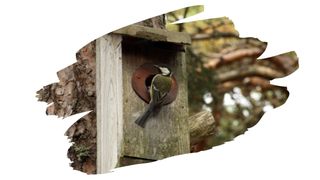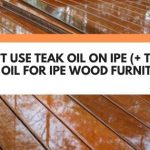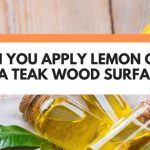Oil finishes make it possible for wood to last decades without succumbing to rot and decay. Which is why wood finishing is such a key step to completing any kind of wood craft.
Yet when it comes to wood finishes, (and our feathered friends), you don’t want to take any chances. Whether you’re making a bird house or a bird feeder, you need to be sure your nesting box project is 100% bird-friendly.
But, using the wrong type of oil finish on a bird house could mean you end up doing more harm than good. So, out of all the different oil finishes, is teak oil safe to use on an outdoor birdhouse?
Teak oil is not a natural oil. In fact, it doesn’t even contain any real teak wood oil.
Instead, this oil finish is made from a blend of different natural oil finishes, solvents, and other chemicals. As a result, it is poisonous for birds.
But, if a teak oil finish is out of the question, is there another outdoor wood sealer that’s bird-friendly?
Well, in this post, you will learn why most wood sealers aren’t suitable for an outdoor bird house. And we reveal what you should really be doing to make that bird house 100% safe for our winged pals…

This post may contain affiliate links to products that we receive a commission for (at no additional cost to you). Learn more here.
Are Wood Oil Finishes, (Such As Teak Oil), Safe For Birds?
Any wood oil finish that contains solvents and chemicals will be harmful to birds. And teak oil is one such finish.
Teak oil is not a natural oil, and it is very toxic. Despite it’s name, this oil does not come from teak wood. In fact, it does not contain any teak wood oils in it at all.
Related Post: Can You Apply Teak Oil On Maple Wood? (Best Practice Revealed)
Rather, it is made by blending natural oils (such as Linseed oil or Tung oil), with toxic ingredients such as mineral spirits and thinners. But having said that, once a teak oil finish has cured, it is no longer toxic.
Curing is a chemical reaction that all drying oil finishes go through. And it is a different, (and much longer), process than drying.
Related Post: Teak Oil Not Drying? (What You Need To Know)
When teak oil goes through it’s drying process, it solvent content evaporates, leaving behind a soft but solid film coat. However, when teak oil cures, it goes through a separate polymerization process. And this is what turns it into a hard durable film coat.
Once teak oil has cured, (which will take around 30 days after application), it becomes a food safe non-toxic surface.
However, all of this doesn’t take into account that some birds like to chew the wood of a bird house. So, if a bird house has been coated in teak oil, then even a cured oil finish can pose a significant risk to our more chew-happy feathery pals.
Related Post: Is There A Bird Safe Paint For Wood? (+ Why VOC’s Are The Real Problem)
In short, don’t use teak oil to seal a birdhouse or bird feeder. And you most certainly should not use it to seal any bird toys. It’s just not worth the risk.

So What Kind Of Exterior Wood Sealer Is Safe For Birds?
If you want to coat a wood preserving finish onto a bird house, that finish needs to meet three key criteria;
1). It needs to be waterproof.
The wood finish needs to be waterproof, or else it will easily wash off in a rain shower.
2). It needs to be non-toxic to birds.
Related Post: Is There A Safe Non-Toxic Wood Sealer For Chicken Coops?
3). It should only be applied on the exterior of the box.
The interior of a bird box should always be left bare — free of any kind of wood preserving film coat.
Here’s the thing; wood sealers that are waterproof, tend to be harmful to birds. And wood sealers that are not harmful to birds, aren’t very waterproof.
Waterproof wood sealers have chemicals added to them to help them repel water. And these chemicals mean that an oil-based (or water-based) exterior wood preserver product isn’t going to be completely pet-safe.
Wood sealers that are all natural, (making them pet-safe), aren’t great at waterproofing. They are water-repellent at most, and are better suited for interior wood structures.
For example, raw Linseed oil is a natural bird-safe wood preservative.
But, Linseed oil is not a great wood sealer, as it succumbs far too easily to water damage, mold, and mildew. In other words, the last thing you want to do is coat an outdoor bird house with Linseed oil.

So, How Do You Preserve A Wooden Bird Box?
The safest approach for birds would be for you to leave that lumber untreated and unfinished.
Now, this goes against every wood finishing bone in my body. But, honestly, leaving that birdhouse timber in its raw state is the safest play.
You see, you only need to seal a bird box if you need that box to last for decades.
But, if left unfinished, most untreated wood can keep it together for about 2 years. Plus, naturally rot-resistant timber can last up to 5 years if left untreated.
So, make your bird box out of wood that’s both naturally rot-resistant and bird safe.
For example, untreated Pine wood and untreated Walnut wood are two bird safe timbers that also happen to be very rot-resistant.
To Wrap Up, Here Are The 3 Main Takeaways…
- 1). Teak oil is not a natural finish, and it contains solvents. Which is why its not safe to use this finish on birdhouses.
- 2). Exterior wood preserving finishes contain chemicals that are harmful to birds.
- 3). Ideally, leave bird houses untreated and unfinished. And use bird-safe rot-resistant wood, (such as Pine or Walnut), to make your birdhouse.



